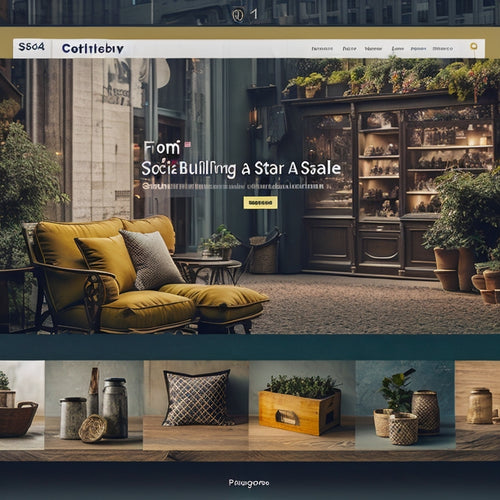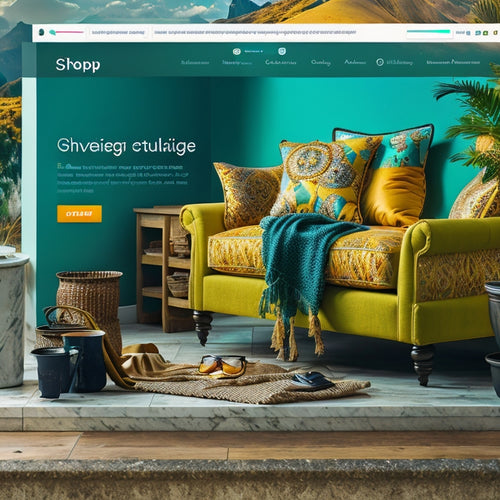
Revamp E-Commerce Success: Masterful Website Design
Share
You know that a masterful website design is the key to your e-commerce success, driving conversions and setting your brand apart from the competition. A consumer-centric approach resonates with customers' needs, increasing engagement and driving sales. A well-designed site establishes credibility, guides buyers through the process, and guarantees quick load speeds. To build trust, prioritize transparency, and include essential elements like mobile-first design, lightning-fast speeds, and prominent contact info. You're just getting started - discover the essential design elements and user experience factors that will take your e-commerce site to the next level.
Key Takeaways
• A well-crafted website design is essential for e-commerce success, driving conversions through an immersive user experience.
• A consumer-centric approach matters, focusing on guiding and answering questions rather than being sales-oriented.
• Building trust and credibility is crucial, achieved through transparency, reliability, and essential design elements like SSL certificates.
• Simple and consistent navigation, paired with fast load speeds under 3 seconds, ensures a seamless user experience.
• A mobile-first design with engaging visual elements and micro-interactions can entertain and motivate users to share content and drive revenue.
Effective E-Commerce Web Design
As you start on your e-commerce journey, a well-crafted website design emerges as the linchpin that can make or break your online success. It's the key to creating an immersive user experience that drives conversions.
A well-designed site isn't just visually appealing, but also technically sound, ensuring seamless navigation and fast page load speeds. This fusion of creativity and technicality is vital for boosting user engagement and conversion optimization.
Consumer-Centric Approach Matters
By putting yourself in your customers' shoes, you can create an e-commerce website that genuinely resonates with their needs and preferences. This consumer-centric approach matters because it allows you to design a site that caters to their desires, increasing user engagement and driving conversions.
You'll avoid being overly pushy or sales-oriented, instead focusing on guiding and answering their questions. Your website will align with their expectations, making them feel seen and heard. By prioritizing customer preferences, you'll create a seamless conversion journey that builds trust and credibility.
This approach is pivotal for online success, as it fosters a connection with your customers and sets your brand apart from the competition.
Benefits of Well-Designed Sites
You'll be hard-pressed to find an online shopper who doesn't prefer interacting with a well-designed website, as a visually appealing and intuitive interface instantly establishes credibility and trust. A well-designed site is like a warm welcome, making you feel comfortable and valued. This leads to increased engagement, as you're more likely to explore and interact with the site.
Improved conversions are a natural result, as a seamless user experience guides you through the buying process. A well-designed site also loads quickly, ensuring you don't get frustrated and bounce off. With engaging design elements and micro-interactions, you'll be entertained and motivated to share content, ultimately driving revenue and growth.
Building Trust and Credibility
Establishing trust and credibility with online consumers is vital, since they're more likely to share sensitive information and make purchases from a website that exudes transparency and reliability.
You want to create a digital space where visitors feel comfortable and secure, which is pivotal for building trust and credibility. To achieve this, you must prioritize transparency importance by providing complete contact information, shipping and return policies, testimonials, and an about section.
This credibility building strategy will enhance user trust and encourage conversions. A trustworthy design is essential for online consumer trust, so make sure to include these essential elements in your website design.
Essential Design Elements Checklist
As you embark on developing a stellar e-commerce website, a key checklist of essential design elements awaits, highlighting mobile-first design, speedy load times, and an SSL certificate, among other must-haves.
Your website's success hinges on integrating these pivotal elements to create a smooth user experience. Here's a checklist to get you started:
-
Mobile-first design: Ensure your site adjusts to various devices and screen sizes for optimal visual aesthetics.
-
Lightning-fast load speeds: Aim for load times under 3 seconds to prevent abandonment and enhance engagement.
-
SSL certificate: Encrypt data transmission to establish trust and credibility with your users.
-
Simple and consistent navigation: Lead users through your site with intuitive, user-friendly navigation.
-
Prominent contact information: Make it simple for users to get in touch with questions or concerns.
Enhancing User Experience Factors
By incorporating intuitive micro-interactions, engaging visuals, and clear typography, your e-commerce website can effortlessly guide users through a seamless conversion journey, greatly enhancing their overall user experience.
You can create an immersive experience by using subtle animations, smooth effects, and hover effects that respond to user interaction. This will make your website feel more dynamic and responsive, encouraging users to engage with your content.
Additionally, a visually appealing design with high-quality images and videos will capture users' attention, making them more likely to explore your website.
Protecting Consumer Data Matters
Protecting consumer data becomes a top priority when you realize that a single breach can shatter trust, leading to a mass exodus of customers and a damaged brand reputation. As an e-commerce business owner, it's vital to prioritize data privacy and compliance regulations to maintain customer trust.
Here are some essential measures to take:
-
Implement strong encryption methods to safeguard sensitive information
-
Conduct regular security audits to identify vulnerabilities
-
Ensure GDPR and CCPA compliance for EU and California consumers, respectively
-
Develop a thorough data privacy policy that outlines data collection and usage
-
Train employees on data handling best practices to prevent human error
Optimizing for Conversions Success
You've secured your customers' trust by protecting their data, now it's time to capitalize on that trust by designing a seamless conversion journey that guides them toward making a purchase. To optimize for conversions, focus on creating a user-friendly interface that aligns with your customers' needs. This includes implementing effective conversion strategies, such as clear calls-to-action, minimal form fields, and a streamlined checkout process.
| Conversion Strategy | Website Aesthetics | User Interface |
|---|---|---|
| Clear CTAs | Simple and clean design | Intuitive navigation |
| Minimal form fields | High-quality product images | Responsive design |
| Streamlined checkout | Consistent branding | Personalized recommendations |
| Social proof | Fast page load speeds | Trust badges and security indicators |
Frequently Asked Questions
How Often Should I Update My E-Commerce Website's Design?
You should update your e-commerce website's design every 2-3 years to stay current with design trends, ensuring a seamless user experience, especially on mobile, and boosting conversion rates to keep your customers coming back.
Can I Use a Website Builder or Do I Need a Custom Design?
You're wondering if you should use a website builder or opt for a custom design? A custom design offers tailored solutions for a unique user experience, while website builders provide ease and efficiency, but may lack responsiveness and flexibility.
What Is the Ideal Number of Website Pages for an E-Commerce Site?
You're wondering how many pages your e-commerce site needs? Aim for 7-10 core pages, including a homepage, product pages, and about/contact sections, ensuring SEO optimization and a seamless user experience that guides customers through their conversion journey.
How Do I Ensure My Website Is Accessible for People With Disabilities?
'Imagine a world where everyone can browse with ease, like a sailor sailing a calm sea. To guarantee your website is accessible, you'll need to chart a course through inclusive design, meeting accessibility standards in web development to create a seamless user experience for all.'
What Are the Best Practices for Conducting A/B Testing on an E-Commerce Site?
When conducting A/B testing on your e-commerce site, you'll boost conversion rates by optimizing user experience through split testing, meticulously analyzing data, and making informed design decisions that drive sales and customer satisfaction.
Related Posts
-

How Do I Get Social Proof on Shopify
This article explores the concept of obtaining social proof on the Shopify platform. It highlights the benefits of i...
-

Do SEO Apps Work on Shopify
This article examines the efficacy of SEO apps on the Shopify platform. The objective of this analysis is to determi...
-

What Is the Best Automation Tool for Shopify
This article examines the topic of identifying the most effective automation tool for Shopify. It explores the benef...


